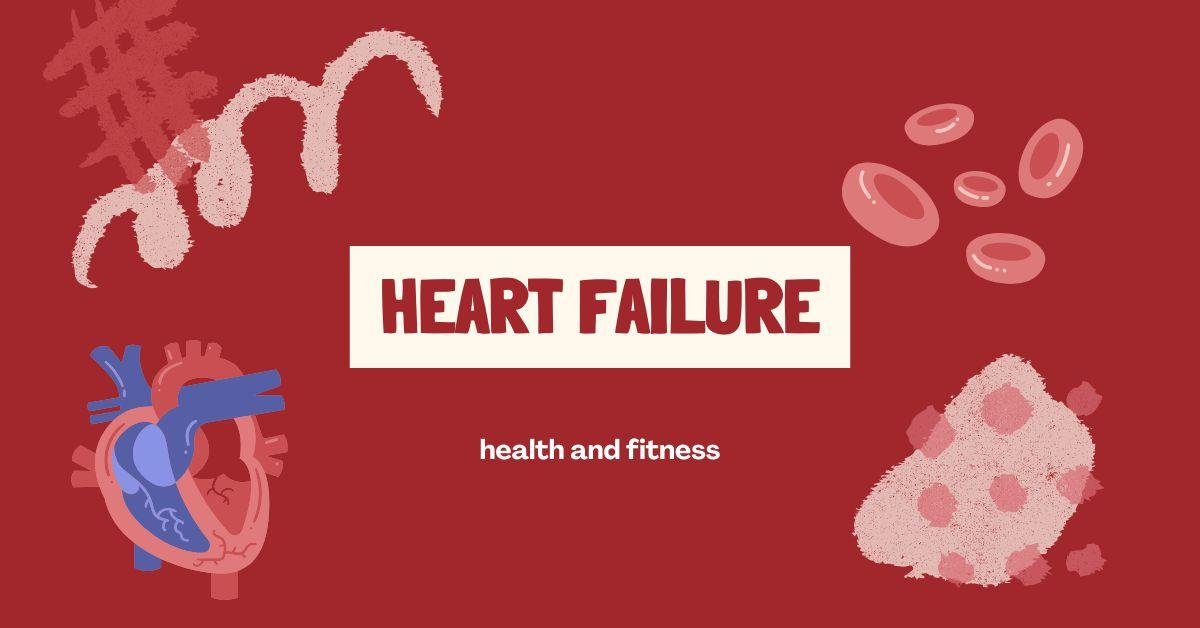When your heart cannot pump enough blood to meet your body’s needs, you can develop heart failure, commonly referred to as congestive heart failure. This may occur if your heart is unable to pump enough blood. It may also occur if your heart is not strong enough to pump blood effectively. Being diagnosed with “heart failure” does not indicate that your heart has ceased beating. Heart failure, however, is a dangerous illness that requires medical attention.
The Centers for Disease Control and Prevention estimate that over 6 million adults in the US suffer from heart failure. Although this health subject focuses on adult heart failure, children can also have heart failure.
Acute heart failure can occur quickly, but chronic heart failure develops gradually as the heart weakens. One or both sides of your heart may be impacted. The causes of cardiac failure on the left and right sides may differ. Heart failure is typically brought on by another illness that harms the heart. This encompasses heart conditions such as coronary heart disease, inflammation of the heart, hypertension, cardiomyopathy, or irregular heartbeat. Symptoms of heart failure may not appear immediately. Eventually, though, you can experience exhaustion and dyspnea and observe an accumulation of fluid in your neck, stomach, or lower body.
Kidney or liver disease can result from heart failure. Pulmonary hypertension and other cardiac disorders, such as an irregular heartbeat, are among the numerous diseases it might cause.
What factors increase the risk of cardiovascular disease?
Unhealthy eating, sedentary lifestyles, tobacco use, and excessive alcohol use are the main behavioural risk factors for heart disease and stroke. Air pollution is one of the major environmental risk factors. Individuals may experience elevated blood pressure, elevated blood glucose, elevated blood lipids, and overweight or obesity as a result of behavioural risk factors. A higher risk of heart failure, stroke, heart failure, and other consequences is indicated by these “intermediate risk factors,” which can be assessed in primary care settings.
The risk of heart disease has been demonstrated to be decreased by quitting smoking, consuming less salt, eating more fruits and vegetables, engaging in regular physical activity, and abstaining from problematic alcohol consumption. Encouraging individuals to adopt and maintain healthy behaviours requires health policies that improve air quality, reduce pollution, and create favourable conditions for making healthy options accessible and inexpensive.
Additionally, there are several underlying factors that contribute to CVDs. These reflect the main dynamics of urbanization, population ageing, and globalization that are causing social, economic, and cultural change. Hereditary factors, stress, and poverty are other determinants of CVDs.
To lower cardiovascular risk, medications are also required to manage diabetes, excessive blood lipids, and hypertension.
What signs and symptoms are typical of heart conditions?
Heart attack and stroke symptoms
The underlying blood vessel illness frequently has no symptoms. The initial indication of an underlying disease could be a heart attack or stroke. Heart attack symptoms include:
Ache or discomfort in the middle of the chest, as well as in the arms, back, jaw, elbows, or left shoulder.
The person may also feel lightheaded or faint, have a cold sweat, turn pale, have trouble breathing or shortness of breath, or experience nausea or vomiting. Back or jaw discomfort, nausea, vomiting, and shortness of breath are more common in women than in males.
Abrupt weakness of the face, arm, or leg, usually on one side of the body, is the most typical sign of a stroke. Additional symptoms include the abrupt development of:
Facial, arm, or leg numbness, particularly on one side of the body; confusion, trouble speaking or understanding speech; vision problems in one or both eyes; dizziness, loss of balance, or lack of coordination; a severe headache without a known cause; fainting or unconsciousness.
Those who are exhibiting these symptoms ought to get medical help right away.
Rheumatic heart failure: what is it?
The inflammation and scarring brought on by rheumatic fever harm the heart muscle and valves, which results in rheumatic heart failure. The body’s aberrant reaction to a streptococcal bacterial infection, which typically starts as tonsillitis or a sore throat in children, is what causes rheumatic fever.
Children in poor nations, particularly those with high rates of poverty, are primarily affected by rheumatic fever. Rheumatic heart disease accounts for around 2% of cardiovascular disease-related fatalities worldwide.
Rheumatic heart disease symptoms
Breathlessness, exhaustion, irregular heartbeats, chest pain, and fainting are all signs of rheumatic heart disease.
Rheumatic fever symptoms include fever, joint pain and swelling, nausea, cramping in the stomach, and vomiting.
Why do cardiovascular disorders pose a challenge to the development of low- and middle-income nations?
In low- and middle-income nations, cardiovascular diseases account for at least three-quarters of all deaths worldwide. People in low- and middle-income nations frequently lack access to basic healthcare programs that can identify and treat individuals with cardiovascular disease risk factors early on. Individuals with CVDs and other noncommunicable illnesses who live in low- and middle-income nations have reduced access to efficient and fair healthcare services that meet their needs. Because of this, many people in these nations die from CVDs and other noncommunicable diseases at a younger age, frequently during their most productive years, and identification of the disease is commonly delayed.
In low- and middle-income nations, the most impacted are the poorest citizens. Evidence is mounting that, at the household level, noncommunicable diseases like CVDs and others lead to poverty because of their high out-of-pocket costs and catastrophic health spending. At the macroeconomic level, low- and middle-income countries’ economies are severely impacted by CVDs.
What steps may be taken to lessen the burden of cardiovascular diseases?
The inclusion of cardiovascular disease management strategies in universal health care packages is crucial for reducing cardiovascular disease, even if many nations’ health systems need significant investment and reorientation to manage CVD effectively.
Overview:
When the heart muscle is unable to pump blood as effectively as it should, heart failure results. Shortness of breath can result from fluid accumulation and blood backing up in the lungs.
Over time, several cardiac disorders cause the heart to become too weak or rigid to fill and pump blood adequately. These conditions include elevated blood pressure and cardiac artery narrowing.
With the proper care, heart failure symptoms may be lessened, and some people may survive longer. A lifestyle change can enhance one’s quality of life. Make an effort to control stress, exercise, cut back on salt, and lose weight.
However, cardiac failure can be fatal. Heart failure patients may experience severe symptoms. A heart transplant or a gadget to aid in the heart’s blood pumping may be necessary for some people.
Congestive heart failure is another name for heart failure.
A weak, injured, or rigid heart can result in cardiac failure.
The heart chambers may enlarge and stretch if the heart is weak or injured. The required amount of blood cannot be pumped out by the heart.
The ventricles, the heart’s primary pumping chambers, cannot fill with enough blood in between beats if they are stiff.
Certain illnesses, excessive alcohol use, illicit drug use, and certain chemotherapy medications can all harm the heart muscle. Your genes may also be involved.
Heart failure can also result from any of the following disorders that weaken or damage the heart.
Heart attacks and coronary artery disease. The most frequent cause of heart failure is coronary artery disease. The accumulation of fatty deposits in the arteries causes the illness. The deposits constrict the arteries. A heart attack may result from this decrease in blood flow.
When an artery supplying the heart becomes clogged, a heart attack happens abruptly. The heart may no longer be able to pump blood as effectively if the heart muscle is damaged during a heart attack.
Elevated blood pressure. This disorder, also known as hypertension, makes the heart work harder than it should to pump blood throughout the body. The cardiac muscle may become too weak or rigid to adequately pump blood as a result of the additional strain over time.
Heart valve disorders. The heart’s valves maintain proper blood flow. The heart has to work harder to pump blood when a valve is not functioning correctly. Over time, this may weaken the heart. Heart failure may be reversed by treating specific heart valve issues.
Myocarditis is another name for inflammation of the heart muscle. Left-sided heart failure may result from myocarditis, which is most frequently brought on by a virus, such as the COVID-19 virus.
A congenital heart defect is a heart condition that you are born with. The other components of the heart must work harder to pump blood if the heart and its chambers or valves are not correctly formed. Heart failure could result from this.
Arrhythmias are irregular heartbeats. The heart may beat too quickly due to irregular heart rhythms, which puts additional strain on the organ. Heart failure can also result from a slow heartbeat. For some patients, heart failure can be reversed by treating an abnormal cardiac rhythm.
Other illnesses. Some chronic diseases may exacerbate chronic heart failure. A buildup of iron or protein, diabetes, HIV infection, or an overactive or underactive thyroid are a few examples.





